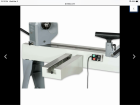odie
TOTW Team
- Joined
- Dec 22, 2006
- Messages
- 7,116
- Likes
- 9,816
Just in case anyone else here is interested in knowing more about the RP Regent lathe.......I skipped over this one before, because it's narrated in Russian, but it's a very good video showing more than the other vids I've seen on this lathe.
Note: Specs are at 2:30
Alignment of spindle to tailstock at 6:30
-----odie-----
View: https://youtu.be/zSUIAAHX26M
Note: Specs are at 2:30
Alignment of spindle to tailstock at 6:30
-----odie-----
Last edited:

